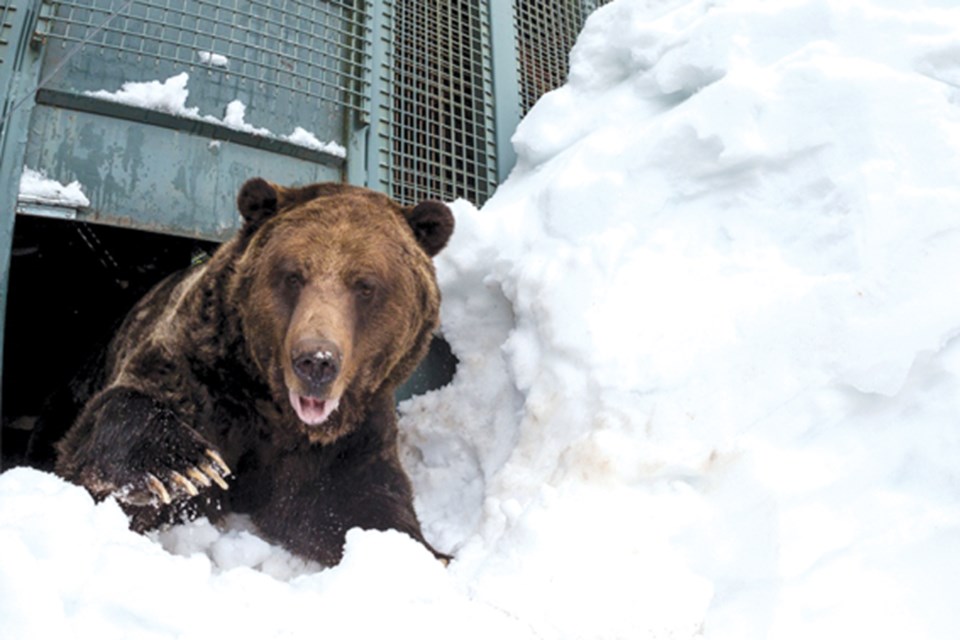Two big paws and long claws easily tear through a large snow bank and Grinder sticks his head out.
Of course it’s Grinder. He is always first.
In the 16 years that Grinder and Coola have lived on Grouse Mountain, Grinder has always been the first one to emerge from hibernation.
“He is the smaller, dominant bear,” reports Ken Macquisten, refuge director and veterinarian. “Just before they came out I said I’ll give a-thousand-to-one odds on which bear is going to come out first, and there were quite a few people there and nobody took me up on it. Nobody wanted to risk a dollar.”
The two resident grizzly bears emerged on April 28 after 151 days of sleeping. It was a long hibernation, just one day short of their previous record of 152 days.
Macquisten says the day of awakening is the “highlight of the year” for him and his team because they haven’t seen the bears for so long, except on an infrared camera that shows the inside of the hibernation den throughout the winter.
“It has to be kind of a co-ordinated effort between us and them,” he says of the day they pop out.
Toward the end of winter, as spring approaches, the bears start to arouse from their sleep, he explains. In the wild, bears will get up to check out the food situation around them and see if it’s worth staying up or going back to bed.
Grinder and Coola do the same, and as their stirrings become more frequent Macquisten and his team know it’s time to make sure their outside habitat is ready. That mainly means putting back the fence on the external enclosure. Each winter, the fence has to be taken down because creeping snow masses can cause damage.
Grinder and Coola spend their winter in a “bear hotel” that includes a hibernation den and an area for them to get up and stretch their legs. When they start doing that more often toward the end of their hibernation, the refuge team knows it’s almost time.
Macquisten explains that all bears go through a form of hibernation as a way of conserving energy to get through periods in the wild when food is scarce. True hibernators experience a significant drop in body temperature and are difficult to wake up, notes Macquisten. That is not the case with Grinder and Coola. Theirs is not a true hibernation, rather it is referred to as a period of dormancy.
While they are asleep for five months they don’t eat and they don’t expel waste (take bathroom breaks).
“The den is as clean when they come out as it was when they went in,” says Macquisten.
Their bodies go through a physiological change that is still a bit of a mystery to scientists, he adds.
As they’re sleeping, they do occasionally shift position and they experience an automatic shiver reflex that helps maintain muscle and bone strength.
When they breathe in, they shiver, and when they exhale they relax. That action keeps their muscles and bones in good shape, explains Macquisten.
When they are preparing for the bears to emerge, the refuge team makes sure there is a good-sized snow bank for them to dig out through.
“We like them to do that because it makes them feel like they’re in control of the operation, and bears like to feel like they’re in control,” says Macquisten, adding Coola won’t push through a smaller opening like Grinder will.
“Grinder is more adventurous,” he notes. “As soon as he can get his body through he pops out, but Coola’s got to make sure that every last little bit of opening is made so that he can come out and not get trapped.”
In past years Coola has been slow to emerge so Grinder has gone back to the snow bank to help make the opening bigger and urge him along.
“He’s a bit of a nervous guy,” Macquisten says of Coola.
Once they’re out, it doesn’t take long for the adopted brothers to start playing. Although they are considered adults, they act more like cubs, rolling in the snow and wrestling with each other.
“They’re just joyous. They grab each other and play and they so appreciate each other’s company,” says Macquisten. “Bears have a tremendous sense of humour and an inherent joy of life, and they look for fun things to do.”
Sometimes they will climb to the top of a snow pile and slide down, then do it again and again.
“They do that just for the pure pleasure of it,” says Macquisten, noting bears are considered highly intelligent animals and intelligent animals tend to enjoy play.
Although many of us waking up from a long sleep may crave a breakfast burrito or three, Macquisten says the grizzlies aren’t very hungry when they emerge. Their digestive systems are slow to start moving so they reintroduce food by first nibbling on leafy greens, like lettuce, then graduating to kibbles and later to fruits and vegetables.
During their hibernation the bears lose between 25 and 30 per cent of their body weight. Grinder weighed in at just under 700 pounds after hibernation this year. He was 900 pounds when he went in.
And Coola? Well . . .
“We can’t convince Coola to get on the scale,” says Macquisten with a laugh.
“You can make Coola do anything he wants to do,” he jokes. “But you can’t make him do anything he doesn’t want to do.”



